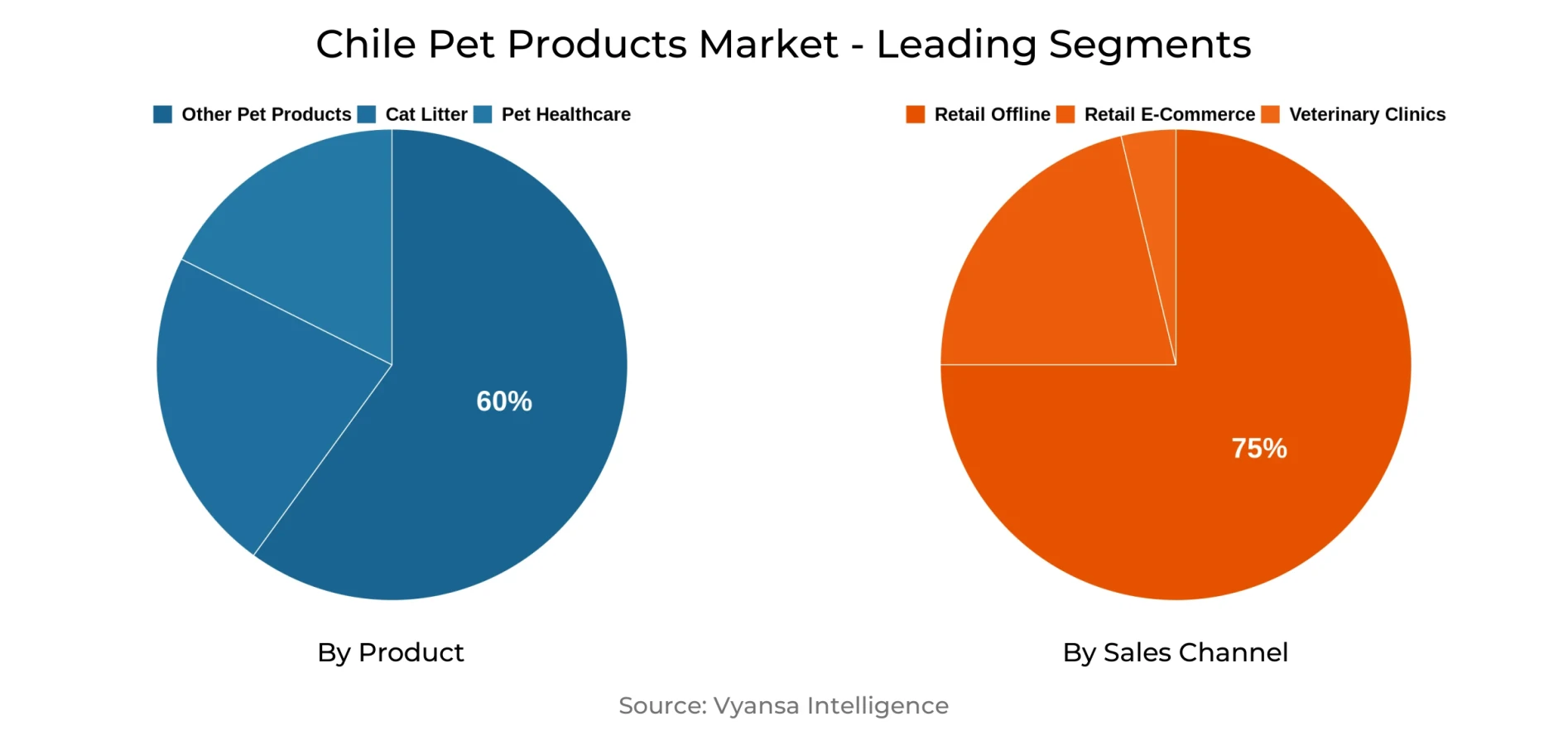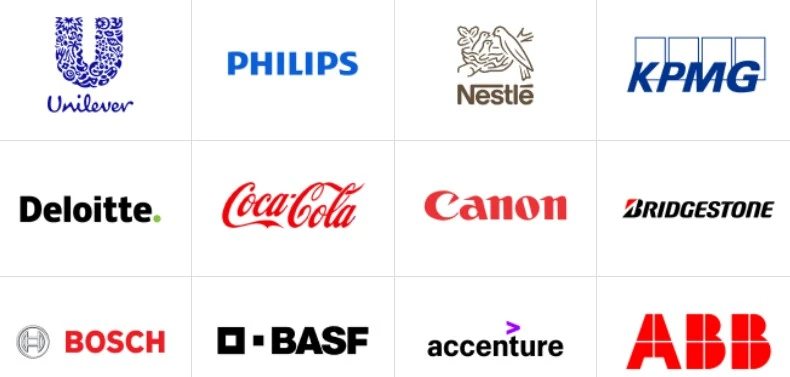Chile Pet Products Market Report: Trends, Growth and Forecast (2025-2030)
By Product (Cat Litter, Pet Healthcare (Flea/Tick Treatments, Pet Dietary Supplements, Worming Treatments, Others), Other Pet Products (Beauty Products, Accessories, Others)), By Sales Channel (Retail Offline, Retail E-Commerce, Veterinary Clinics)
- FMCG
- Dec 2025
- VI0289
- 129
-




Chile Pet Products Market Statistics and Insights, 2025
- Market Size Statistics
- Pet Products in Chile is estimated at $ 245 Million.
- The market size is expected to grow to $ 310 Million by 2030.
- Market to register a CAGR of around 4% during 2025-30.
- Product Shares
- Other Pet Products grabbed market share of 60%.
- Competition
- More than 15 companies are actively engaged in producing Pet Products in Chile.
- Top 5 companies acquired 20% of the market share.
- Cencosud SA, Champion SA, Agrícola Nacional SAC e I, Intervet Veterinaria Chile Ltd, Bayer SA etc., are few of the top companies.
- Sales Channel
- Retail Offline grabbed 75% of the market.
Chile Pet Products Market Outlook
The Chile pet products market, worth $245 million currently, is projected to expand steadily to $310 million by 2030. Growth will be underpinned by an improving economy, resulting in increased disposable incomes and higher expenditure on pets. Pets are now considered part of the family by many Chile, particularly younger generations, driving demand for products such as toys, grooming, and healthcare products.
End users tastes are changing towards high-quality, sustainable, and technically advanced pet products. The pet humanisation trend continues to dominate the market, prompting pet owners to spend money on smart feeders, GPS collars, and environmentally friendly products. For instance, Stay Happy's biodegradable cat litter and Bravecto's focused marketing campaigns have helped retain top market positions. Despite a fragmented market with over 15 active companies, the top five players account for 20% of the market share, highlighting growing competition.
Sales channels wise, Retail offline continues to lead with 75% of total sales. Hypermarkets are popular due to their convenience, but superstores, pet shops and the internet channel are picking up pace. The most dynamic and rapidly evolving channel is e-commerce, with increased visibility for products and customers making choices based on information. Social media and influencer marketing are also being used by brands to interact with pet owners directly.
During the next five years, sustained innovation and growing distribution channels will propel market growth. With increasing awareness of pet health, wellness, and sustainability, businesses that operate in functional and green product spaces are likely to experience robust demand.

Chile Pet Products Market Growth Driver
A better economic condition within the nation is causing increased disposable income among pet owners. They are thus able to spend more on various pet products, fueling constant growth of the market. As they become financially better off, pet owners are spending more on things that help improve their pets' quality of life, including grooming products, toys, and health care products.
Concurrently, pets are playing an increasingly integral role in day-to-day living, particularly among younger generations. They provide companionship and emotional support, something that has been reinforced by recent global happenings such as the pandemic and increased digital isolation. These emotional bonds are driving ongoing spending on premium pet products, ensuring the demand remains elevated on various categories.
Chile Pet Products Market Trend
The pet products Market is witnessing a robust movement towards tech-enabled solutions. Pet owners are willing to spend more on devices that enhance the care process. GPS collars with real-time tracking capabilities are becoming popular as they provide peace of mind for pets engaged in outdoor activities. Smart feeders and water dispensers are becoming mainstream, keeping pets fed and watered even when owners are not present. Some feeders even have food intake measured through in-built scales, promoting weight control and sustainability.
Innovation today is aimed at offering technological, eco-friendly, and health-focused solutions. With the rise of pet humanisation, owners are looking for high-tech, quality products. Intelligent toys for physical and cognitive stimulation, water-resistant apparel, and GPS gadgets are some of the most sought-after products. These items can easily be found in stores such as Super Zoo and Club de Perros y Gatos, and their availability is likely to increase even more with the rising demand.
| Report Coverage | Details |
|---|---|
| Market Forecast | 2025-30 |
| USD Value 2024 | $ 245 Million |
| USD Value 2030 | $ 310 Million |
| CAGR 2025-2030 | 4% |
| Largest Category | Other Pet Products segment leads with 60% market share |
| Top Drivers | Rising Disposable Income and Changing Lifestyles Supporting Market Growth |
| Top Trends | Growing Demand for Tech-Driven and Sustainable Pet Products |
| Key Players | Cencosud SA, Champion SA, Agrícola Nacional SAC e I, Intervet Veterinaria Chile Ltd, Bayer SA, Sanofi Pasteur SA, Comercial Canada SpA, Laboratorio Drag Pharma Chile Invetec SA, Zoetis de Chile SA, Nestlé Chile SA and Others. |
Chile Pet Products Market Segmentation Analysis

By Sales Channel
- Retail Offline
- Retail E-Commerce
- Veterinary Clinics
The sales channel with the highest market share is offline retail, accounting for 75% of the market during the review period. Hypermarkets are central to this domination, providing a vast range of pet products under one roof. Their extensive reach and convenience all over Chile make them a convenient option for most pet owners. Despite this dominance, hypermarkets are beginning to experience growing competition from pet stores and superstores, which capture shoppers by virtue of differentiated products and tailored service.
Meanwhile, E-commerce is the most rapidly expanding sector of Chile's pet products market. Increasing availability of product information, increased product variety, and the ability to shop online fuel growth. With internet penetration at such high levels, firms are increasingly focusing on developing their online platforms to increase visibility and drive sales. New trends indicate that this transition is an indicator of consumer preference, tending to increasingly favor convenience and informed choice.
Top Companies in Chile Pet Products Market
The top companies operating in the market include Cencosud SA, Champion SA, Agrícola Nacional SAC e I, Intervet Veterinaria Chile Ltd, Bayer SA, Sanofi Pasteur SA, Comercial Canada SpA, Laboratorio Drag Pharma Chile Invetec SA, Zoetis de Chile SA, Nestlé Chile SA, etc., are the top players operating in the Chile Pet Products Market.
Frequently Asked Questions
Related Report
1. Market Segmentation
1.1. Research Scope
1.2. Research Methodology
1.3. Definitions and Assumptions
2. Executive Summary
3. Chile Pet Products Market Policies, Regulations, and Standards
4. Chile Pet Products Market Dynamics
4.1. Growth Factors
4.2. Challenges
4.3. Trends
4.4. Opportunities
5. Chile Pet Products Market Statistics, 2020-2030F
5.1. Market Size & Growth Outlook
5.1.1.By Revenues in US$ Million
5.2. Market Segmentation & Growth Outlook
5.2.1.By Product
5.2.1.1. Cat Litter- Market Insights and Forecast 2020-2030, USD Million
5.2.1.2. Pet Healthcare- Market Insights and Forecast 2020-2030, USD Million
5.2.1.2.1. Flea/Tick Treatments- Market Insights and Forecast 2020-2030, USD Million
5.2.1.2.2. Pet Dietary Supplements- Market Insights and Forecast 2020-2030, USD Million
5.2.1.2.3. Worming Treatments- Market Insights and Forecast 2020-2030, USD Million
5.2.1.2.4. Others- Market Insights and Forecast 2020-2030, USD Million
5.2.1.3. Other Pet Products- Market Insights and Forecast 2020-2030, USD Million
5.2.1.3.1. Beauty Products- Market Insights and Forecast 2020-2030, USD Million
5.2.1.3.2. Accessories- Market Insights and Forecast 2020-2030, USD Million
5.2.1.3.3. Others- Market Insights and Forecast 2020-2030, USD Million
5.2.2.By Sales Channel
5.2.2.1. Retail Offline- Market Insights and Forecast 2020-2030, USD Million
5.2.2.2. Retail E-Commerce- Market Insights and Forecast 2020-2030, USD Million
5.2.2.3. Veterinary Clinics- Market Insights and Forecast 2020-2030, USD Million
5.2.3.By Competitors
5.2.3.1. Competition Characteristics
5.2.3.2. Market Share & Analysis
6. Chile Cat Litter Products Market Statistics, 2020-2030F
6.1. Market Size & Growth Outlook
6.1.1.By Revenues in US$ Million
6.2. Market Segmentation & Growth Outlook
6.2.1.By Sales Channel- Market Insights and Forecast 2020-2030, USD Million
7. Chile Pet Healthcare Market Statistics, 2020-2030F
7.1. Market Size & Growth Outlook
7.1.1.By Revenues in US$ Million
7.2. Market Segmentation & Growth Outlook
7.2.1.By Product- Market Insights and Forecast 2020-2030, USD Million
7.2.2.By Sales Channel- Market Insights and Forecast 2020-2030, USD Million
8. Chile Other Pet Products Market Statistics, 2020-2030F
8.1. Market Size & Growth Outlook
8.1.1.By Revenues in US$ Million
8.2. Market Segmentation & Growth Outlook
8.2.1.By Product- Market Insights and Forecast 2020-2030, USD Million
8.2.2.By Sales Channel- Market Insights and Forecast 2020-2030, USD Million
9. Competitive Outlook
9.1. Company Profiles
9.1.1.Intervet Veterinaria Chile Ltd
9.1.1.1. Business Description
9.1.1.2. Product Portfolio
9.1.1.3. Collaborations & Alliances
9.1.1.4. Recent Developments
9.1.1.5. Financial Details
9.1.1.6. Others
9.1.2.Bayer SA
9.1.2.1. Business Description
9.1.2.2. Product Portfolio
9.1.2.3. Collaborations & Alliances
9.1.2.4. Recent Developments
9.1.2.5. Financial Details
9.1.2.6. Others
9.1.3.Sanofi Pasteur SA
9.1.3.1. Business Description
9.1.3.2. Product Portfolio
9.1.3.3. Collaborations & Alliances
9.1.3.4. Recent Developments
9.1.3.5. Financial Details
9.1.3.6. Others
9.1.4.Comercial Canada SpA
9.1.4.1. Business Description
9.1.4.2. Product Portfolio
9.1.4.3. Collaborations & Alliances
9.1.4.4. Recent Developments
9.1.4.5. Financial Details
9.1.4.6. Others
9.1.5.Laboratorio Drag Pharma Chile
9.1.5.1. Business Description
9.1.5.2. Product Portfolio
9.1.5.3. Collaborations & Alliances
9.1.5.4. Recent Developments
9.1.5.5. Financial Details
9.1.5.6. Others
9.1.6.Invetec SA
9.1.6.1. Business Description
9.1.6.2. Product Portfolio
9.1.6.3. Collaborations & Alliances
9.1.6.4. Recent Developments
9.1.6.5. Financial Details
9.1.6.6. Others
9.1.7.Cencosud SA
9.1.7.1. Business Description
9.1.7.2. Product Portfolio
9.1.7.3. Collaborations & Alliances
9.1.7.4. Recent Developments
9.1.7.5. Financial Details
9.1.7.6. Others
9.1.8.Champion SA
9.1.8.1. Business Description
9.1.8.2. Product Portfolio
9.1.8.3. Collaborations & Alliances
9.1.8.4. Recent Developments
9.1.8.5. Financial Details
9.1.8.6. Others
9.1.9.Agrícola Nacional SAC e I
9.1.9.1. Business Description
9.1.9.2. Product Portfolio
9.1.9.3. Collaborations & Alliances
9.1.9.4. Recent Developments
9.1.9.5. Financial Details
9.1.9.6. Others
9.1.10. Zoetis de Chile SA
9.1.10.1. Business Description
9.1.10.2. Product Portfolio
9.1.10.3. Collaborations & Alliances
9.1.10.4. Recent Developments
9.1.10.5. Financial Details
9.1.10.6. Others
10. Disclaimer
| Segment | Sub-Segment |
|---|---|
| By Product |
|
| By Sales Channel |
|
Research Methodology
This study followed a structured approach comprising four key phases to assess the size and scope of the electro-oxidation market. The process began with thorough secondary research to collect data on the target market, related markets, and broader industry context. These findings, along with preliminary assumptions and estimates, were then validated through extensive primary research involving industry experts from across the value chain. To calculate the overall market size, both top-down and bottom-up methodologies were employed. Finally, market segmentation and data triangulation techniques were applied to refine and validate segment-level estimations.
Secondary Research
The secondary research phase involved gathering data from a wide range of credible and published sources. This step helped in identifying industry trends, defining market segmentation, and understanding the market landscape and value chain.
Sources consulted during this phase included:
- Company annual reports, investor presentations, and press releases
- Industry white papers and certified publications
- Trade directories and market-recognized databases
- Articles from authoritative authors and reputable journals
- Gold and silver standard websites
Secondary research was critical in mapping out the industry's value chain and monetary flow, identifying key market segments, understanding regional variations, and tracking significant industry developments.
Other key sources:
- Financial disclosures
- Industry associations and trade bodies
- News outlets and business magazines
- Academic journals and research studies
- Paid industry databases
Primary Research
To validate secondary data and gain deeper market insights, primary research was conducted with key stakeholders across both the supply and demand sides of the market.
On the demand side, participants included decision-makers and influencers from end-user industries—such as CIOs, CTOs, and CSOs—who provided first-hand perspectives on market needs, product usage, and future expectations.
On the supply side, interviews were conducted with manufacturers, industry associations, and institutional participants to gather insights into current offerings, product pipelines, and market challenges.
Primary interviews provided critical inputs such as:
- Market size and revenue data
- Product and service breakdowns
- Market forecasts
- Regional and application-specific trends
Stakeholders consulted included:
- Leading OEM and solution providers
- Channel and distribution partners
- End users across various applications
- Independent consultants and industry specialists
Market Size Estimation and Data Triangulation
- Identifying Key Market Participants (Secondary Research)
- Goal: To identify the major players or companies in the target market. This typically involves using publicly available data sources such as industry reports, market research publications, and financial statements of companies.
- Tools: Reports from firms like Gartner, Forrester, Euromonitor, Statista, IBISWorld, and others. Public financial statements, news articles, and press releases from top market players.
- Extracting Earnings of Key Market Participants
- Goal: To estimate the earnings generated from the product or service being analyzed. This step helps in understanding the revenue potential of each market player in a specific geography.
- Methods: Earnings data can be gathered from:
- Publicly available financial reports (for listed companies).
- Interviews and primary data sources from professionals, such as Directors, VPs, SVPs, etc. This is especially useful for understanding more nuanced, internal data that isn't publicly disclosed.
- Annual reports and investor presentations of key players.
- Data Collation and Development of a Relevant Data Model
- Goal: To collate inputs from both primary and secondary sources into a structured, data-driven model for market estimation. This model will incorporate key market KPIs and any independent variables relevant to the market.
- Key KPIs: These could include:
- Market size, growth rate, and demand drivers.
- Industry-specific metrics like market share, average revenue per customer (ARPC), or average deal size.
- External variables, such as economic growth rates, inflation rates, or commodity prices, that could affect the market.
- Data Modeling: Based on this data, the market forecasts are developed for the next 5 years. A combination of trend analysis, scenario modeling, and statistical regression might be used to generate projections.
- Scenario Analysis
- Goal: To test different assumptions and validate how sensitive the market is to changes in key variables (e.g., market demand, regulatory changes, technological disruptions).
- Types of Scenarios:
- Base Case: Based on current assumptions and historical data.
- Best-Case Scenario: Assuming favorable market conditions, regulatory environments, and technological advancements.
- Worst-Case Scenario: Accounting for adverse factors, such as economic downturns, stricter regulations, or unexpected disruptions.
Partnering With Industry Leaders to Drive Growth
Our mission is to deliver intelligence that matters. By combining data, analysis, and industry expertise, we enable organizations to make smarter, faster, and more impactful decisions. Whether it’s a Fortune 500 company or a high-growth startup, businesses trust us to provide clarity in an ever-evolving marketplace.






